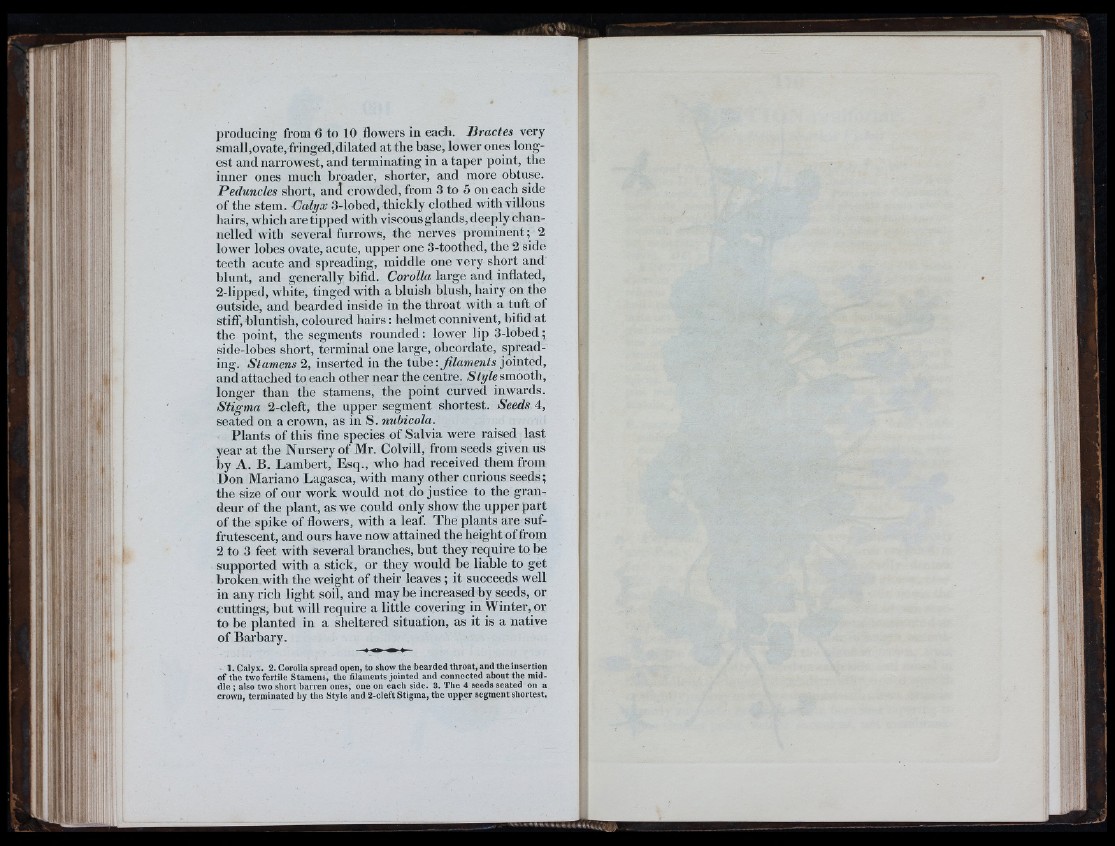
producing from 6 to 10 flowers in each. Bractes very
small,ovate, fringed,dilated at the base, lower ones longest
and narrowest, and terminating in a taper point, the
inner ones much broader, shorter, and more obtuse.
Peduncles short, and crowded, from 3 to 5 on each side
of the stem. Calyx 3-lobed, thickly clothed with villous
liairs, which are tipped with viscous glands, deeply channelled
with several furrows, the nerves prominent; 2
lower lobes ovate, acute, upper one 3-toothed, the 2 side
teeth acute and spreading, middle one very short and
blunt, and generally bifid. Corolla large and inflated,
2-lipped, white, tinged with a bluish blush, hairy on the
outside, and bearded inside in the throat with a tuft of
stiff, bluntish, coloured hairs; helmet connivent, bifid at
the point, the segments rounded: lower lip 3-lobed;
side-lobes short, terminal one large, obcordate, spreading.
Stamens 2, inserted in the tube: filaments jointed,
and attached to each other near the centre. Nfy/e smooth,
longer than the stamens, the point curved inwards.
Stigma 2-cleft, the upper segment shortest. Seeds 4,
seated on a crown, as in S. nubicola.
Plants of this fine species of Salvia were raised last
year at the Nursery of Mr. Colvill, from seeds given us
by A. B- Lambert, Esq., who had received them from
Don Mariano Lagasca, with many other curious seeds;
the size of our work Avould not do justice to the grandeur
of the plant, as we could only show the upper part
of the spike of flowers, with a leaf. The plants are suffrutescent,
and ours have now attained the height of from
2 to 3 feet with several branches, but they require to be
supported with a stick, or they would be liable to get
broken with the weight of their leaves; it succeeds well
in any rich light soil, and may be increased by seeds, or
cuttings, but will require a little covering in Winter, or
to be planted in a sheltered situation, as it is a native
of Barbary.
1. Calyx. 2. Corolla spread open, to show th e b e a rd ed th ro a t, and th e insertion
o f th e two fertile Stamens, the filaments jo in ted and conne cted about the midd
le ; also two short b a rren ones, one on ea ch side. 3. The 4 seeds seated on a
crown, te rmina ted by the Style and 2-cleft S tigma, the u p p e r segment shortest.
1 'ii:
i f
' ' ¡i','
m
■’f i ■ ■ :] !]